Eric Chen
Artists' Views on Robotics Involvement in Painting Productions
Oct 08, 2025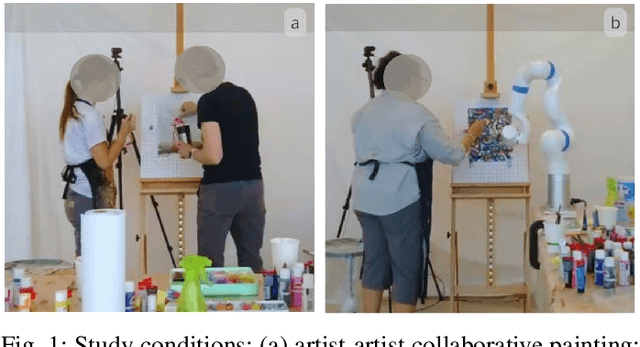
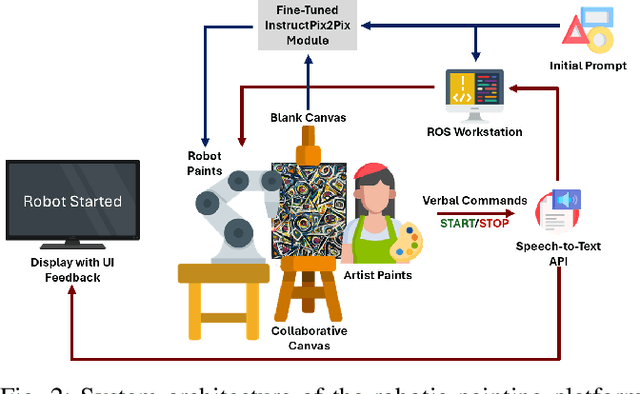
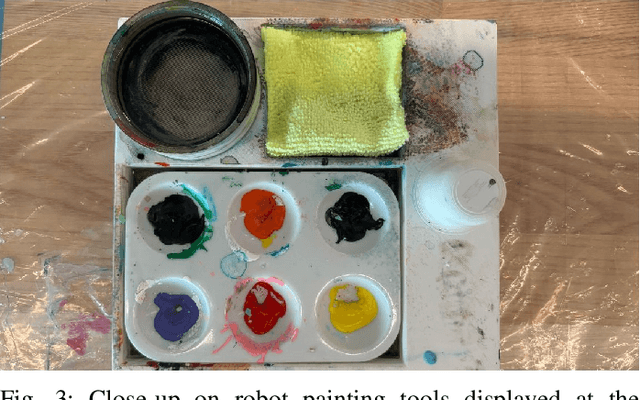
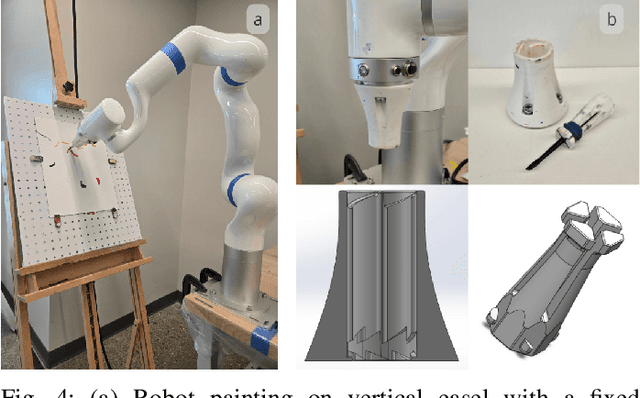
Abstract:As robotic technologies evolve, their potential in artistic creation becomes an increasingly relevant topic of inquiry. This study explores how professional abstract artists perceive and experience co-creative interactions with an autonomous painting robotic arm. Eight artists engaged in six painting sessions -- three with a human partner, followed by three with the robot -- and subsequently participated in semi-structured interviews analyzed through reflexive thematic analysis. Human-human interactions were described as intuitive, dialogic, and emotionally engaging, whereas human-robot sessions felt more playful and reflective, offering greater autonomy and prompting for novel strategies to overcome the system's limitations. This work offers one of the first empirical investigations into artists' lived experiences with a robot, highlighting the value of long-term engagement and a multidisciplinary approach to human-robot co-creation.
Building Machine Learning Challenges for Anomaly Detection in Science
Mar 03, 2025



Abstract:Scientific discoveries are often made by finding a pattern or object that was not predicted by the known rules of science. Oftentimes, these anomalous events or objects that do not conform to the norms are an indication that the rules of science governing the data are incomplete, and something new needs to be present to explain these unexpected outliers. The challenge of finding anomalies can be confounding since it requires codifying a complete knowledge of the known scientific behaviors and then projecting these known behaviors on the data to look for deviations. When utilizing machine learning, this presents a particular challenge since we require that the model not only understands scientific data perfectly but also recognizes when the data is inconsistent and out of the scope of its trained behavior. In this paper, we present three datasets aimed at developing machine learning-based anomaly detection for disparate scientific domains covering astrophysics, genomics, and polar science. We present the different datasets along with a scheme to make machine learning challenges around the three datasets findable, accessible, interoperable, and reusable (FAIR). Furthermore, we present an approach that generalizes to future machine learning challenges, enabling the possibility of large, more compute-intensive challenges that can ultimately lead to scientific discovery.
Comprehensive Examination of Unrolled Networks for Linear Inverse Problems
Jan 08, 2025



Abstract:Unrolled networks have become prevalent in various computer vision and imaging tasks. Although they have demonstrated remarkable efficacy in solving specific computer vision and computational imaging tasks, their adaptation to other applications presents considerable challenges. This is primarily due to the multitude of design decisions that practitioners working on new applications must navigate, each potentially affecting the network's overall performance. These decisions include selecting the optimization algorithm, defining the loss function, and determining the number of convolutional layers, among others. Compounding the issue, evaluating each design choice requires time-consuming simulations to train, fine-tune the neural network, and optimize for its performance. As a result, the process of exploring multiple options and identifying the optimal configuration becomes time-consuming and computationally demanding. The main objectives of this paper are (1) to unify some ideas and methodologies used in unrolled networks to reduce the number of design choices a user has to make, and (2) to report a comprehensive ablation study to discuss the impact of each of the choices involved in designing unrolled networks and present practical recommendations based on our findings. We anticipate that this study will help scientists and engineers design unrolled networks for their applications and diagnose problems within their networks efficiently.
How Your Location Relates to Health: Variable Importance and Interpretable Machine Learning for Environmental and Sociodemographic Data
Jan 03, 2025



Abstract:Health outcomes depend on complex environmental and sociodemographic factors whose effects change over location and time. Only recently has fine-grained spatial and temporal data become available to study these effects, namely the MEDSAT dataset of English health, environmental, and sociodemographic information. Leveraging this new resource, we use a variety of variable importance techniques to robustly identify the most informative predictors across multiple health outcomes. We then develop an interpretable machine learning framework based on Generalized Additive Models (GAMs) and Multiscale Geographically Weighted Regression (MGWR) to analyze both local and global spatial dependencies of each variable on various health outcomes. Our findings identify NO2 as a global predictor for asthma, hypertension, and anxiety, alongside other outcome-specific predictors related to occupation, marriage, and vegetation. Regional analyses reveal local variations with air pollution and solar radiation, with notable shifts during COVID. This comprehensive approach provides actionable insights for addressing health disparities, and advocates for the integration of interpretable machine learning in public health.
Vibe-Eval: A hard evaluation suite for measuring progress of multimodal language models
May 03, 2024
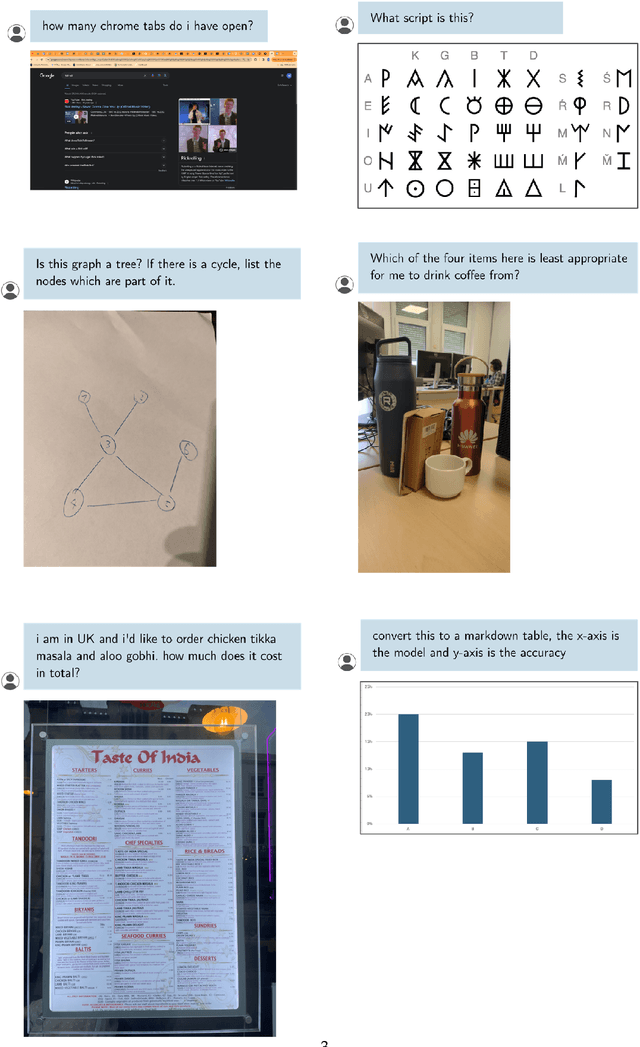
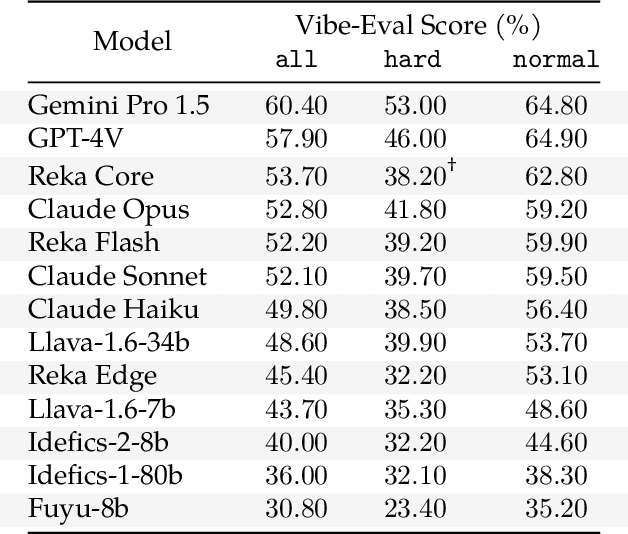
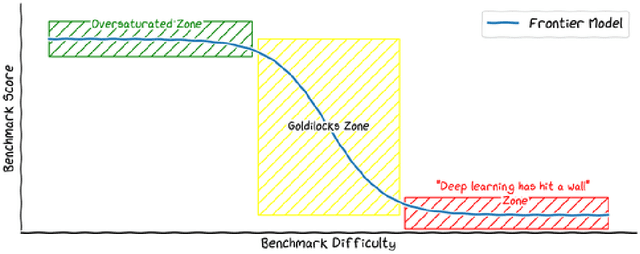
Abstract:We introduce Vibe-Eval: a new open benchmark and framework for evaluating multimodal chat models. Vibe-Eval consists of 269 visual understanding prompts, including 100 of hard difficulty, complete with gold-standard responses authored by experts. Vibe-Eval is open-ended and challenging with dual objectives: (i) vibe checking multimodal chat models for day-to-day tasks and (ii) rigorously testing and probing the capabilities of present frontier models. Notably, our hard set contains >50% questions that all frontier models answer incorrectly. We explore the nuances of designing, evaluating, and ranking models on ultra challenging prompts. We also discuss trade-offs between human and automatic evaluation, and show that automatic model evaluation using Reka Core roughly correlates to human judgment. We offer free API access for the purpose of lightweight evaluation and plan to conduct formal human evaluations for public models that perform well on the Vibe-Eval's automatic scores. We release the evaluation code and data, see https://github.com/reka-ai/reka-vibe-eval
Reka Core, Flash, and Edge: A Series of Powerful Multimodal Language Models
Apr 18, 2024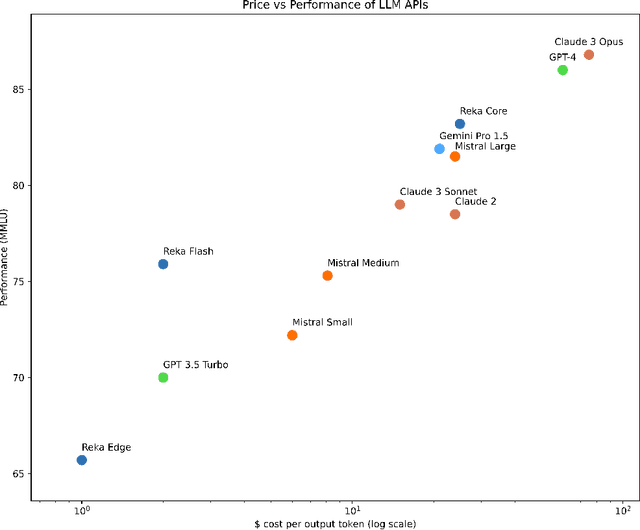


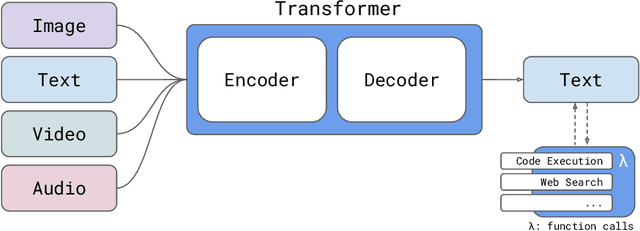
Abstract:We introduce Reka Core, Flash, and Edge, a series of powerful multimodal language models trained from scratch by Reka. Reka models are able to process and reason with text, images, video, and audio inputs. This technical report discusses details of training some of these models and provides comprehensive evaluation results. We show that Reka Edge and Reka Flash are not only state-of-the-art but also outperform many much larger models, delivering outsized values for their respective compute class. Meanwhile, our most capable and largest model, Reka Core, approaches the best frontier models on both automatic evaluations and blind human evaluations. On image question answering benchmarks (e.g. MMMU, VQAv2), Core performs competitively to GPT4-V. Meanwhile, on multimodal chat, Core ranks as the second most preferred model under a blind third-party human evaluation setup, outperforming other models such as Claude 3 Opus. On text benchmarks, Core not only performs competitively to other frontier models on a set of well-established benchmarks (e.g. MMLU, GSM8K) but also outperforms GPT4-0613 on human evaluation. On video question answering (Perception-Test), Core outperforms Gemini Ultra. Models are shipped in production at http://chat.reka.ai . A showcase of non cherry picked qualitative examples can also be found at http://showcase.reka.ai .
Telling Left from Right: Identifying Geometry-Aware Semantic Correspondence
Nov 28, 2023



Abstract:While pre-trained large-scale vision models have shown significant promise for semantic correspondence, their features often struggle to grasp the geometry and orientation of instances. This paper identifies the importance of being geometry-aware for semantic correspondence and reveals a limitation of the features of current foundation models under simple post-processing. We show that incorporating this information can markedly enhance semantic correspondence performance with simple but effective solutions in both zero-shot and supervised settings. We also construct a new challenging benchmark for semantic correspondence built from an existing animal pose estimation dataset, for both pre-training validating models. Our method achieves a PCK@0.10 score of 64.2 (zero-shot) and 85.6 (supervised) on the challenging SPair-71k dataset, outperforming the state-of-the-art by 4.3p and 11.0p absolute gains, respectively. Our code and datasets will be publicly available.
Neuro-Inspired Fragmentation and Recall to Overcome Catastrophic Forgetting in Curiosity
Oct 26, 2023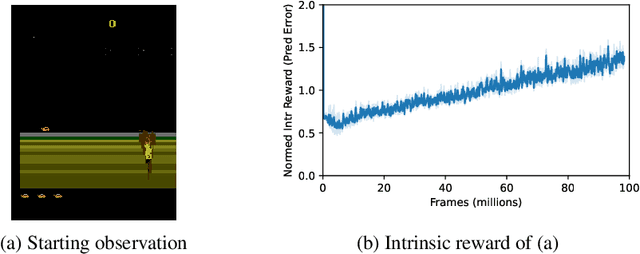
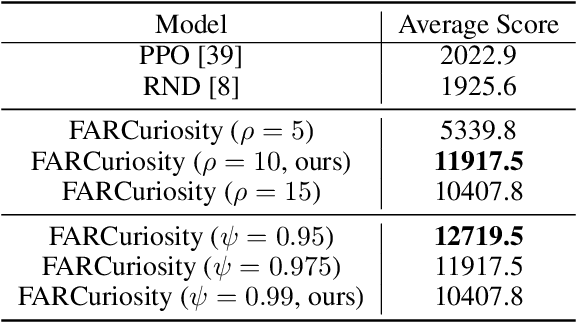


Abstract:Deep reinforcement learning methods exhibit impressive performance on a range of tasks but still struggle on hard exploration tasks in large environments with sparse rewards. To address this, intrinsic rewards can be generated using forward model prediction errors that decrease as the environment becomes known, and incentivize an agent to explore novel states. While prediction-based intrinsic rewards can help agents solve hard exploration tasks, they can suffer from catastrophic forgetting and actually increase at visited states. We first examine the conditions and causes of catastrophic forgetting in grid world environments. We then propose a new method FARCuriosity, inspired by how humans and animals learn. The method depends on fragmentation and recall: an agent fragments an environment based on surprisal, and uses different local curiosity modules (prediction-based intrinsic reward functions) for each fragment so that modules are not trained on the entire environment. At each fragmentation event, the agent stores the current module in long-term memory (LTM) and either initializes a new module or recalls a previously stored module based on its match with the current state. With fragmentation and recall, FARCuriosity achieves less forgetting and better overall performance in games with varied and heterogeneous environments in the Atari benchmark suite of tasks. Thus, this work highlights the problem of catastrophic forgetting in prediction-based curiosity methods and proposes a solution.
Neuro-Inspired Efficient Map Building via Fragmentation and Recall
Jul 11, 2023Abstract:Animals and robots navigate through environments by building and refining maps of the space. These maps enable functions including navigating back to home, planning, search, and foraging. In large environments, exploration of the space is a hard problem: agents can become stuck in local regions. Here, we use insights from neuroscience to propose and apply the concept of Fragmentation-and-Recall (FarMap), with agents solving the mapping problem by building local maps via a surprisal-based clustering of space, which they use to set subgoals for spatial exploration. Agents build and use a local map to predict their observations; high surprisal leads to a ``fragmentation event'' that truncates the local map. At these events, the recent local map is placed into long-term memory (LTM), and a different local map is initialized. If observations at a fracture point match observations in one of the stored local maps, that map is recalled (and thus reused) from LTM. The fragmentation points induce a natural online clustering of the larger space, forming a set of intrinsic potential subgoals that are stored in LTM as a topological graph. Agents choose their next subgoal from the set of near and far potential subgoals from within the current local map or LTM, respectively. Thus, local maps guide exploration locally, while LTM promotes global exploration. We evaluate FarMap on complex procedurally-generated spatial environments to demonstrate that this mapping strategy much more rapidly covers the environment (number of agent steps and wall clock time) and is more efficient in active memory usage, without loss of performance.
Learning-on-the-Drive: Self-supervised Adaptation of Visual Offroad Traversability Models
Jun 27, 2023



Abstract:Autonomous off-road driving requires understanding traversability, which refers to the suitability of a given terrain to drive over. When offroad vehicles travel at high speed ($>10m/s$), they need to reason at long-range ($50m$-$100m$) for safe and deliberate navigation. Moreover, vehicles often operate in new environments and under different weather conditions. LiDAR provides accurate estimates robust to visual appearances, however, it is often too noisy beyond 30m for fine-grained estimates due to sparse measurements. Conversely, visual-based models give dense predictions at further distances but perform poorly at all ranges when out of training distribution. To address these challenges, we present ALTER, an offroad perception module that adapts-on-the-drive to combine the best of both sensors. Our visual model continuously learns from new near-range LiDAR measurements. This self-supervised approach enables accurate long-range traversability prediction in novel environments without hand-labeling. Results on two distinct real-world offroad environments show up to 52.5% improvement in traversability estimation over LiDAR-only estimates and 38.1% improvement over non-adaptive visual baseline.
 Add to Chrome
Add to Chrome Add to Firefox
Add to Firefox Add to Edge
Add to Edge